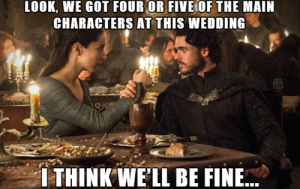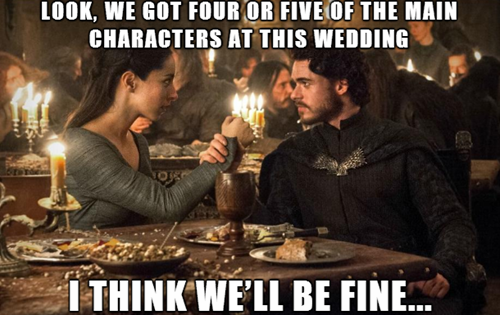The episode titled “The Rains of Castamere” broke the viewers of Game of Thrones and the internet in one blow. Every person who had not read the book series A Song of Ice and Fire witnessed an event now known as the Red Wedding and slowly felt their love of the series go up in flames as some of their favourite characters were murdered at a wedding. The episode got a lot of attention on social media with people complaining that their favourite characters died. Many sites had twitter responses (like the ones recorded on mashable.com) that highlighted the displeasure of fans. The reason this shocked so many people was not only the brutality of the murders but also that it was assumed these people were safe under something called the sacred law of hospitality.

The importance of hospitality is one of the many aspects of Northern European cultures that are heavily based on kinship; Martin borrows from these cultures to create the Westerosi (and specifically Northern) law of hospitality. In both cases, people in living in cold climates need to be able to depend on their neighbor and the wider community to help them in times of need. When going about your normal day or travelling, winter storms can wreck any plans you might have for the evening. Being able to call upon a stranger for protection from the harsh environment would save many lives. In the Norse Sagas, hospitality and the rights and responsibilities of guests crop up frequently as an extremely important part of Norse culture. In order for the guest right to properly work, both parties involved needed to be respectful. As a guest, you were expected to return the favour through a gift or a service. This practice helped save the host and the guests through the winters as it would create a small scale trade network. When instances of this were violated there have been severe repercussions.
Within the lore of A Song of Ice and Fire there is an instance of this being broken. The Rat Cook is a tale about a man who kills the king’s son and then bakes him into a pie and then serves it to the king. He was ultimately turned into a rat that ate its own young. This was not because of his pie making, but because he broke the law of hospitality for killing someone under his care. The importance of taking care of your guests is a high priority and can be punishable as seen through the Rat Cook. In current time period in Westeros, folk of the North still thought of this tradition as extremely important.
Martin draws on many aspects of life when he writes and history is one of them. The infamous Red Wedding is based off a historical instance known as the Black Dinner and the Glencoe massacre. There were some articles posted on the internet shortly after the original airing of the episode. The Huffington Post and The Week both had articles on the historical parallels. The Black Dinner in 1400 was an event in Scotland. The Chancellor of Scotland felt that the Black Douglas Clan was gaining too much power and sought to end them. The Black Douglas clan was invited to a feast under the guise of hoping to better the relationship between the two parties. Safe passage was also promised. When the dinner happens, the Chancellor’s men bring a symbol of death in the form of the head of a black boar. The whole Douglas clan was murdered.
The Glencoe Massacre happened in 1692, and also took place in Scotland. It begins with a succession problem between two kings, James VII and King William of Orange. James had recently been deposed and all the clans were to swear oaths to William. The MacDonald clan came across problems in the process of trying to sign the treaty, as the Secretary of State did not like them, and they had sworn an oath to James. They were in process of formally dissolving it when the deadline arrived. Another clan, the Campbells saw this as the MacDonalds were not serious about their oaths and set out to erase them. One hundred and fifty Campbells arrived in Glencoe, where the MacDonalds lived, and used the guest right to stay the night. After everyone went to bed, the Campbells murdered 38 people.
The instance of “murder under trust” as seen in the various examples is a worse act than normal murder. Martin uses this within Game of Thrones. The Red Wedding is such an instance, but there is another that is closer to how it can be violated. The Mutiny at Craster’s Keep happened in A Storm of Swords and involves the small band of surviving Night’s Watch. They seek shelter with Craster, but some of the Night’s Watch rebel thinking Craster is hiding food. It results with chaos and the death of the Craster and Lord Commander Mormont along with various Watchmen. Much later on, the people still living at the keep are all killed by the wight, Coldhands.
The reactions to the Red Wedding throughout the various kingdoms make it clear that it was an act worse than murder. Martin has stated “No matter how much I make up, there’s stuff in history that’s just as bad, or worse.” Many readers and viewers think Martin is just creating situations just for the novelty and impact but such things have happened in history.
More information regarding Germanic culture and how it is used within Martin’s world can be seen within various parts of A World of Ice and Fire by G.R.R. Martin, Elio M. Garcia, Jr., and Linda Antonsson (New York: Bantam, 2014). The most pertinent information is found in the sections on ‘The North’ and ‘The Wall and Beyond’. The wiki for A Song of Ice and Fire has pages on Guest right, The Red Wedding and the Mutiny at Craster’s Keep.
As part of a class assignment last year for the class ML300 at Wilfrid Laurier University, Ryan Orr wrote a paper on the connections of Germanic Culture and Martin’s world. It provides details on many other aspects of Germanic culture found in Martin’s storyworld, such as trial by combat along with more information about hospitality.
Volume 37 (2011) of the Journal of Medieval History was a special issue containing a variety of papers on different aspects of medieval community, including hospitality, feasting, and gift giving. Lars Kjaer and A.J. Watson’s article, “Feasts and Gifts: Sharing Food in the Middle Ages” (pg 1-5) and Kjaer’s second article, “Food, drink, and ritualised communication in the household of Eleanor de Montfort, February to August 1265” (pg 75-89) can provide additional contextual information for medieval hospitality.
